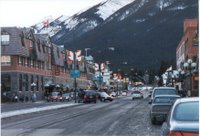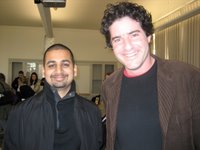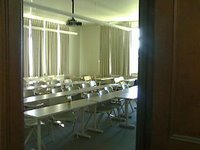on september 24, 1905, filmmaker jack kuttner attached a hand-crank camera to a san francisco streetcar and filmed a few miles down market street.
kuttner's 9-minute footage is vintage - you see old, grand san francisco, you see very busy downtown traffic with death-wish buggies darting in and out, and you see a few humans running in and around the frame who seem to know, and relish, that the whole scene was being filmed. six months later, in april, the 1906 earthquake and fire devastated the city.
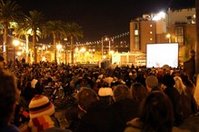
100 years later, filmmakers melinda stone and liz keim decided to recreate the historic event. on september 24, 2005, they hosted a free and public film screening in a park across from the ferry building. they screened the original 1905 film as well as new 2005 trips down market street. by all accounts, the evening was magical. fortunately, a lot of it is captured on a dvd called
a trip down market street 1905/2005.
personal context: melinda stone and i teach
media studies at the university of san francisco. she's on sabbatical, building and living on
stonelake farm, where
sarah and
i visited and met emily chapman and chris "
my blog is a typewriter" fettin. emily was melinda's research assistant, a contributor to the film, and an integral part of the project; chris was an actor on one of the 2005 clips ("w.w. stone and the lincoln monument league of 1914"). on saturday night, emily and chris joined sarah and me and we ate, drank, and watched
a trip down market street 1905/2005.
the dvd is incredible. there's multiple ways of watching it but we began with the source: kuttner's "a trip down market street 1905" (9 minutes, originally shot on 35 mm) with an amazing musical accompaniment composed by beth custer and performed by the beth custer ensemble. then we watched "market street after the fire 1906," filmmaker unknown (4 minutes, 35 mm), courtesy of rick prelinger (a portion is available at
internetarchive.org). the film records a stunned population walking towards and away from the heart of the city, a ghost town, a city that has been destroyed by an earthquake and fire. accompanying the footage is dave cerf's sounds, sound clouds, and sound storms. the first film is silent and vibrant; the second film is scathing and haunting.

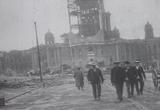
after refilling our glasses, we moved to the 2005 films! the dvd features commissioned films by
kerry laitala,
rachel manera,
katherin mcinnis,
tomonari nishikawa, and
ken paul rosenthal. it also has short/shorter films by
christian bruno, emily chapman (who's fantastic short, "honey," is "inspired by the 1970s spirit of Sylvester and the Cockettes"), and melinda stone. there's also some documentary footage of old market street including "vj day celebration," by c. r. skinner, narration by dick bartel (4 minutes, 16 mm) which captures spontaneous celebrations on market street on august 14, 1945, when world war two ended. in color. incredible.
may we live in such times. and finally, there were a few historical re-enactments, filmic representations of days gone past. my favorite was "w.w. stone and the lincoln monument league of 1914," directed by melinda stone, which explains:
"When Melinda Stone could not find original footage of this organization and their attempts to change the name of Market Street to Lincoln Boulevard, she decided to make the footage herself. More information on the LML can be located in the San Francisco Room at the SF Public Library."

what fun it is to watch a film while sitting in the same room as the lead actor!
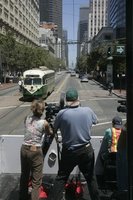
the pathway we took with the dvd ended with "a trip down market street 2005" by melinda stone and sprague anderson, with a score by - again - beth custer and performed by the beth custer ensemble.
as far as i can tell, melinda and sprague were able to convince MUNI to let them attach two cameras - a 35mm hand-crank camera and an HDV camera - to a street car and film market street 100 years after the original. just like kuttner's trip down market street, this one is full of the city, full of buildings and cars and streets and bicycles and traffic, full of people (including marina, zane, milo, and sirrus, not to mention
a smiling sam green in a nice green shirt). but most of all, it's full of perspectives - perspectives of a city so many of us can't get enough of.
what fun it was to watch the films with emily, chris, and sarah. emily was a cookie jar of sweet stories - project stories, stories about the original trip down market street (look closely and you might just see - six times - the same car driving by the camera), and stories about san francisco. what fun it was to hear chris' stories about the film, his role in it, and the night of the public screenings. and what fun it was - or rather is - to find myself in a working and living environment where inspired ideas come to fruition.


 the bob dylan scrapbook, 1956-1966
the bob dylan scrapbook, 1956-1966




















